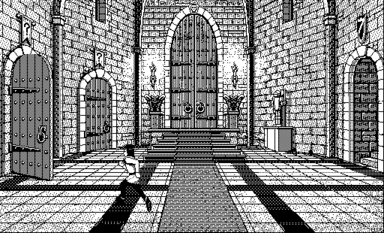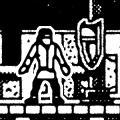Prerelease:Dark Castle (Mac OS Classic, 1986)
This page details prerelease information and/or media for Dark Castle (Mac OS Classic, 1986).
Dark Castle was developed long-distance: designer Mark Stephen Pierce would draw up levels in MacPaint, and programmer Jonathan Gay would receive them on floppy disks in the mail. Some of those MacPaint documents were published in MacUser's April 1987 feature on the game.
Contents
Black Knight 1
| Prerelease | Final |
|---|---|
 |
 |
Status Bar
- The final game only permits collecting up to 89 rocks, whereas this mockup has room for up to 999 stones.
- The final status bar can only display only a 7-digit score and 6 elixirs, as opposed to 9 digits and 20 elixirs in the mockup. However, the mockup has no slots for a bonus countdown or a dungeon key.
- The prerelease fireball icon has an extra tongue of flame, and the shield icon is taller (like the actual in-game shield).
- The prerelease status text is set in Geneva 10 instead of Geneva 9.
Level Layout
- The stairs to the lower left would become a small platform in the final, with the nearest rope lowered to match.
- S and E mark possible locations of stones and elixir. They were unchanged, except that the leftmost pairs were shifted to the right.
- R marks a rope that rats can slide down. In the final, rats do not use the short rope over the small platform with elixir.
Gameplay
Pierce's notes suggest a few ways of saving processor time, none of which proved necessary:
- Only bringing out guards when the player reaches the right half of the screen
- Only putting rats on ropes within a few steps of the player's current position
- Only allowing one rat at a time per small platform (it's two in the final)
He adds that the "stop beams" (white circles) on the ropes might slow down sliding rats, "if you want to get fancy."
Another note specifies that when standing in the lower right corner, the player should have to duck to avoid being killed by the guard. In the final, that guard passes harmlessly behind you.
Shield 4
Graphics
Curiously, they ended up going with a two-dimensional shield instead of one that looks better integrated into its environment. The latter shield would only appear on one of the help screens.
| Prerelease | Final |
|---|---|
 |
 |
It probably has to do with the replacement of the original animation for grabbing the shield, which was included among the level notes on the same page.
The final shield pickup sequence uses only the second and fourth of those frames, making it more flexible: you can start it behind the pillar and be subtly nudged into position on the pillar's left as part of the same rapid movement. Keeping the shield identical before and after it's taken lets the jump look natural to the eye without any transition.
This animated mockup shows how the original frames would have fit together:
Gameplay
Instead of bats, the enemy here was meant to be birds, which would fly through the windows and continue to attack you on the roof. In the final game, the windows are purely decorative.
Sound
The list of sounds needed for this level was much shorter in the notes than it would end up being: "Bird screach [sic], thunder, footsteps, falling, thud, rock throw/fireball, magic sound when shield reached."
- In the game, separate sounds are used for picking up the shield and absorbing its power.
- The in-game birds have three vocalizations (arriving, swooping, and dying), none of which is a screech: voice actor Dick Noel modeled their squawking on "1950s hoodlums from the South Side of Chicago". Plus there's the splat made by their falling corpses.
- The sound when you fall to your death is not a "thud" but an expiring sigh.
- In fact, the list omits any mention of the protagonist having a voice. Other Noelisms heard on this level alone include the mumbling when you climb a ladder, the grunt when you jump, the 'dizzy spell' sequence, the scream when you're fried by lightning, and the yelp when you're bitten to death. Suffice to say that this game's sound design got significantly more ambitious during development.
Trouble 3
Along with the annotated mockups covered above, MacUser printed two "replicas" consisting of Pierce's background art populated with cut-and-pasted sprites. The Fireball 2 background is identical to the final, although the magazine cropped the bottom 12 pixels to remove the water and enhance the desolate atmosphere. The Trouble 3 art includes several differences:
| Prerelease | Final |
|---|---|
 |
 |
- The chute into the level looks more like the foot of a playground slide.
- The stairs up from the chute go one step higher, leaving the next flight one step shorter.
- The prisoners have a neutral expression prior to being whipped, rather than hanging their heads. They also lack distinct hands and feet.
- The keys are closer together, on a smaller board.
- There's some extra shading in the gap between the two highest platforms.
- The background art is slightly longer at the bottom and shorter at the top.
- MSP's initials are missing from the corner.
(The missing ladder rung and accompanying dark strip appear to be a printing error rather than a difference in the art.)
Great Hall
One further shot appeared as a preview in the April 1986 Macworld.
| Prerelease | Final |
|---|---|
 |
 |
- Question mark banners were added over the doors on the left.
- The animated open door was cropped at the top and bottom.
- The right side of the floor was completely redrawn, aligning the carpet with the tiles to either side. Shadows toward the bottom and a grid of black floor tiles added further visual interest.
- The plinth under the suit of armor was enlarged, making room for the easter egg Christmas tree, and vertical lines were added in front. A mousehole was introduced between the bricks to the right.
- The flickering torches in the preview shot don't match either of the frames used in the final.
- Once again, MSP signed his initials in the lower right.

